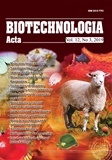ISSN 2410-776X (Online)
ISSN 2410-7751 (Print)

"Biotechnologia Acta" V. 12, No 3, 2019
p. 75-81, Bibliography 24, English
Universal Decimal Classification: 579.6:632.4:633.1
https://doi.org/10.15407/biotech12.03.075
О. Hrytsev1, 2, J. Shevchenko2, N. Vorobiova1, L. Skivka1
1Taras Shevchenko National University of Kyiv, ESC “Institute of Biology and Medicine”, Ukraine
2LLC “Syngenta”, Kyiv, Ukraine
The aim of the study was to develop rapid and sensitive assay for the simultaneous detection of R. cerealis and R. solani. Pure cultures of fungi were grown on a potato dextrose agar for 5 days at 28 °C, and mycelium was harvested and used for DNA extraction. Total DNA was extracted using a commercial test-systems. Molecular identification of phytopathogenic fungi was performed using a multiplex-touchdown PCR with further electrophoretic separation of amplification products in agarose gel. The specific sequence characterized amplified region primers RtubR4/RtubF4 for R. cerealis and ITS1/GMRS–3 for R. solani were tested for their specificity and useability in PCR multiplex capacity. The specificity of the multiplex-touchdown PCR was tested using DNA from wide range of fungal species and non-target DNA from healthy wheat. The used primer pairs provided only specific fragments for R. cerealis and R.solani. No PCR products were obtained during amplification with the negative control or non-target DNA templates from other species. Coupled to this we have optimized the temperature regime for the multiplex PCR protocol. Taken together, our protocol convincingly demonstrated the simultaneous ability to detect Rhizoctonia cerealis and Rhizoctonia solani and can be used for the diagnosis of compound Rhizoctonia root rot.
Key words: phytopathogenic fungi, Rhizoctonia, multiplex PCR.
© Palladin Institute of Biochemistry of National Academy of Sciences of Ukraine, 2019
References
1. Wiesw M. V. Compendium of wheat disease (3rd Ed). St. Paul, USA: APS Press. 1998, 112 p.
2. Kriuchkova L. O. Diseases of winter wheat, caused by necrotroph mushroom pathogens and methods of their diagnosis.: Aftoref. dys. … dok. biol. nauk. Kyiv. 2007, 52 s. (In Ukrainian).
3. Pletnikova N. Root rots of winter wheat. Crop protection. Ahrovіsnyk Ukrainy nauk. vyrobn. zhurn. 2008, N 3, P. 54–56. (In Russian).
4. Dur?n P., Tortella G., Viscardi S., Barra P. J., Carri?n V. J., Mora M. L., Pozo M. J. Microbial Community Composition in Take-All Suppressive Soils. Front Microbiol. 2018, V. 9, P. 2198. https://doi.org/10.3389/fmicb.2018.02198
5. Kwak Y. S., Weller D. M. Take-all of Wheat and Natural Disease Suppression: A Review. Plant Pathol J. 2013, 29 (2), 125–135. https://doi.org/10.5423/PPJ.SI.07.2012.0112
6. Laluk K., Mengiste T. Necrotroph attacks on plants: wanton destruction or covert extortion. Arabidopsis Book. 2010, V. 8, e0136. https://doi.org/10.1199/tab.0136
7. Mengiste T. Plant immunity to necrotrophs. Annu Rev Phytopathol. 2012, V. 50, P. 267–294. https://doi.org/10.1146/annurev-phyto-081211-172955
8. Kriuchkova L. O., Hrytsiuk N. V Root rot of winter wheat — distribution in the northern forest-steppe of Ukraine. Karantyn i zakhyst roslyn 2014, V. 2, P. 9–12. (In Ukrainian).
9. Markov I. L. Phytopathology: textbook / red. I. L. Markova. Kyiv: Feniks. 2016, 492 s. (In Ukrainian).
10. Li W., Guo Y., Zhang A., Chen H. Genetic Structure of Populations of the Wheat Sharp Eyespot Pathogen Rhizoctonia cerealis Anastomosis Group D Subgroup I in China. Phytopathology. 2017, 107 (2), 224–230. https://doi.org/10.1094/PHYTO-05-16-0213-R
11. Lema?czyk G., Kwa?na H. Effects of sharp eyespot (Rhizoctonia cerealis) on yield and grain quality of winter wheat. Eur. J. Plant Pathol. 2013, 135 (1), 187–200. https://doi.org/10.1007/s10658-012-0077-3
12. Hamada M. S., Yin Y. N., Ma Z. H. Detection of Rhizoctonia cerealis in wheat tissues by real-time PCR assay. J. Plant Pathol. 2012, 94 (1), 215–217.
13. Dada T. E. Epidemiology of Wheat Rhizoctonia. Int. J. Sci. Res. Publ. 2017, 7 (5), 463–473.
14. Goll M. B., Schade?Sch?tze A., Swart G., Oostendorp M., Schott J. J., Jaser B., Felsenstein F. G. Survey on the prevalence of Rhizoctonia spp. in European soils and determination of the baseline sensitivity towards sedaxane. Plant Pathology. 2014, V. 63, P. 148–154. https://doi.org/10.1111/ppa.12063
15. Woodhall J. W., Brown M. J., Perkins K., Somoza Valdeolmillos E., Boonham N., Ray R. V. A TaqMan real-time PCR assay for Rhizoctonia cerealis and its 1 use in wheat and soil. Eur. J. Plant Pathol. 2017, 148 (2), 237–245. https://doi.org/10.1007/s10658-016-1083-7
16. Sayler R. J., Yang Y. Detection and Quantification of Rhizoctonia solani AG1 IA, the Rice Sheath Blight Pathogen, in Rice Using Real-Time PCR. Plant Disease. 2007, 91 (12), 1663–1668. https://doi.org/10.1094/PDIS-91-12-1663
17. Chen S., Cao Y., Li T., Wu X. Simultaneous detection of three wheat pathogenic fungal species by multiplex PCR. Phytoparasitica. 2014. https://doi.org/10.1007/s12600-014-0442-1
18. Korbie D. J., Mattick J. S. Touchdown PCR for increased specificity and sensitivity in PCR amplification. Nat. Protoc. 2008, 3 (9), 1452–1456. https://doi.org/10.1038/nprot.2008.133
19. Yingpeng G., Wei L., Haiyan S., Ning W., Hanshou Y., Huaigu C. Detection and quantification of Rhizoctonia cerealis in soil using real-time PCR. J. Gen. Plant Pathol. 2012, 78 (4). https://doi.org/10.1007/s10327-012-0390-x
20. Johanson A., Turner H. C., McKay G. J., Brown A. E. A PCR based method to distinguish fungi of the rice sheath-blight complex, Rhizoctonia solani, R. oryzae and R. oryzae-sativae. FEMS Microbiol. Lett. 1998, 162 (2), 289–294. https://doi.org/10.1016/S0378-1097(98)00136-0
21. Kralik P., Ricchi M. A basic guide to real time PCR in microbial diagnostics: definitions, parameters and everything. Front Microbiol. 2017, V. 8, P. 108. https://doi.org/10.3389/fmicb.2017.00108
22. Sint D., Raso L., Traugott M. Advances in multiplex PCR: balancing primer efficiencies and improving detection success. Meth. Ecol. Evol. 2012, 3 (5), 898–905. https://doi.org/10.1111/j.2041-210X.2012.00215.x
23. Markoulatos P., Siafakas N., Moncany M. Multiplex polymerase chain reaction: a practical approach. J. Clin. Labt. Anal. 2002, V. 16, P. 47–51. https://doi.org/10.1002/jcla.2058
24. Ishii K., Fukui M. Optimization of annealing temperature to reduce bias caused by a primer mismatch in multitemplate PCR. Appl. Environ Microbiol. 2001, 67 (8), 3753–3755. https://doi.org/10.1128/AEM.67.8.3753-3755.2001

